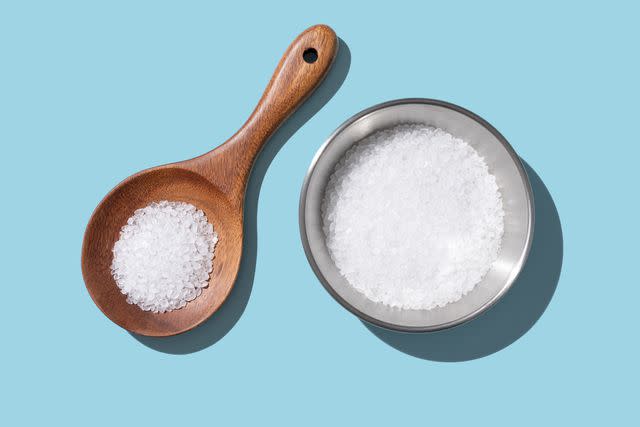Sea Salt vs. Table Salt: What’s the Difference?
Not all salt is the same.
Salt plays an essential role in kitchens worldwide—preserving food, enhancing flavors, modifying textures, and so on. All salt shares the same basic chemical composition, sodium chloride (NaCl), which may lead you to think that all salt is the same. However, the opposite is true. Many factors, including origin and processing, cause different varieties of salt to taste and behave differently. A perfect example is the difference between sea salt and table salt—two common types of salt with significant differences between them. Here, we’re breaking down those differences to help you understand when and how to use sea salt vs. table salt.

MirageC/Getty Images
Related: The (Only) 2 Types of Salt Every Home Cook Needs
What Is Sea Salt?
Sea salt is produced by evaporating saltwater. From there, the salt crystals are minimally processed, which means that they retain trace levels of minerals like calcium, iron, and magnesium. Generally speaking, sea salt is more expensive than table salt for reasons including its labor-intensive production process and perceived higher quality. There are endless varieties of sea salt, which can vary considerably depending on how and where they are harvested and processed.
For example, Maldon Salt comes from the coastal town of Maldon, Essex, in the United Kingdom, and gets processed by evaporating brine over flames to form large, flaky crystals. These factors and more contribute to Maldon Salt’s unique flavor profile and texture. To give another example, Fleur de Sel is a type of sea salt from France that’s harvested from the surface of salt marshes. The resulting crystals have a briny, oceanic flavor and delicate texture, distinct from other sea salts such as Maldon Salt. Thus, there is no singular definition of sea salt, as you can find sea salts with all different textures and flavor profiles to suit your palate and needs.
Sea salt has a long, indefinite shelf life; just make sure to keep it in a dry place, separate from contaminants.
What Is Table Salt?
Table salt is mined from underground salt deposits, then processed to remove other minerals and impurities, with anti-caking agents added to keep it clump-free. Table salt is typically fortified with iodine, a mineral that humans need a small amount of for their health. Iodized salt was first sold in the 1920s in the United States as a public health initiative to counter iodine deficiency.
Table salt has a very fine texture, causing it to dissolve quickly and easily. It also has a clean, straightforwardly salty flavor that can sometimes taste metallic. It tends to be cheaper than sea salt, largely because it’s cost-effective to mine and process. Like sea salt, table salt has a long shelf life and should be stored in a dry place, separate from contaminants.
Related: Kosher Salt vs. Sea Salt: What’s the Difference?
How to Use Sea Salt
Sea salt can be used in a myriad of ways. For example, flakier varieties work well as a finishing touch for dishes like grilled meats, roasted vegetables, or even sweet treats like chocolate chip cookies or brownies. Fine sea salt is best to use throughout the cooking process, because it can be distributed more evenly and it dissolves easily.
How to Use Table Salt
Table salt has a uniform size and salinity, and dissolves easily and quickly. These qualities make it a useful, versatile choice for seasoning while cooking or baking, pickling, preserving, and so on.
Which Type of Salt Has More Sodium?
When measured by weight, sea salt and table salt should have nearly identical levels of sodium. Measuring by volume (i.e. a teaspoon or tablespoon) is a different story. The salt crystals’ shape and size affects the sodium content considerably when measured by volume. For example, one teaspoon of table salt would likely be saltier than one teaspoon of flaky sea salt due to its finer grain and higher density.
Related: 7 Reasons Why You Always Crave Salt—and How to Keep Salty Food Cravings in Check
Is Sea Salt Healthier Than Table Salt?
There’s a widespread belief that sea salt is healthier than table salt, but the truth is that they’re nearly equivalent nutritionally. Sea salt does contain minerals like calcium, iron, and magnesium, but they’re in such small amounts that they don’t impact one’s nutritional intake in a meaningful way. Table salt contains anti-caking agents—an additive that some people prefer to avoid—but the U.S. Food and Drug Administration considers it safe to consume within specified limits. If iodine deficiency is a concern of yours, iodized table salt may be beneficial to your health, but iodine can also be found in many types of seafood, dairy products, and other foods. To summarize, neither salt is decidedly healthier than the other.
For more Real Simple news, make sure to sign up for our newsletter!
Read the original article on Real Simple.


